by G.P.
Mark Ulriksen is a San Francisco-based artist and illustrator. Since 1993 he has been a regular contributor to The New Yorker, where he has published over 150 illustrations, including 20 covers.
He has also painted covers for The Atlantic Monthly, The New York TimesMagazine, Time, Newsweek Japan and Fortune Asia. His first Children’s book, “Dog Show” by Elizabeth Winthrop, willl be published in Fall, 2004.
Ulriksen's work has been recognized by The Society of Illustrators(Gold and Silver medals), American Illustration, Print's Regional Design Annual and Communication Arts, where he was profiled in the May/June 1997 issue. His 1998 and 2002 series of theater posters for Arena Stage in Washington D.C. are in the permanent collection of the Library of Congress. A gallery artist as well, Mark's work has been exhibited in Paris, Rome, Kyoto, New York, Los Angeles and San Francisco.
A 1980 Visual Communications graduate of California State University, Chico, and Bay Area native (San Carlos) Ulriksen spent the first 13 years of his career as a graphic designer and as a magazine art director for San Francisco Focus magazine. He's been illustrating and painting full time since 1994.
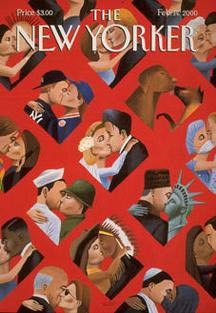
© MarkUlriksen/The New Yorker
I first started working with the New Yorker in 1993 while I was still an art director for the magazine San Francisco Focus. I had sent out samples of my work to various magazines I respected and primarily because of support from magazines like The New Yorker I was able to quit my art director's job and become a full-time freelance illustrator, beginning on 1 Jan, 1994. In the spring of '94 I was asked to try my hand at a New Yorker cover of the Clinton family, focusing primarily on Hillary Clinton. This was unique in my experience with covers for them because for the most part we illustrators submit our own ideas and are not often asked to tackle a specific cover subject.
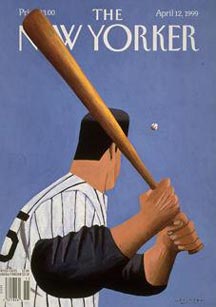
© MarkUlriksen/The New Yorker
"I feel privileged and I'm especially grateful to the artists who have hung in there against all the odds. The rewards are so paltry and the venues so few for somebody who is able to draw and who is able to think, for an artist who can come up with something interesting and funny, for an artist who is engaging with his times. I'm grateful to all the artists who are still artists in this day and age and haven't become scriptwriters for Hollywood (...)"
How would you comment on that?
I'm a lousy script writer so that was never an option. I think Francoise is also commenting on how few magazines in the US these days use illustrations on their covers. We live in a society dominated by the photograph. One of the great things about New Yorker covers is that they do provide a forum for contemporary social commentary and they appreciate and expect a sense of humor from their cover artists.
People understand photography. They take pictures themselves. But an illustration? Folks often don't even know what an illustration or an illustrator is. I've been called a cartoonist many times before.
A photo of a celebrity separates the viewer from the celebrity only through the thin veil of the photographer as an intermediary. That gives it a more powerful allure I would think. Plus I think illustration more often than not needs it's context (the story or the product etc.) to make it's statement and not all illustrations can work well away from their source. But the ones that do are usually the ones that I like the best.
I'm totally fascinated with people. I love to people watch and from an early age I used to doodle on school desks caricatures of my classmates. I also work in solitude so the people in my paintings keep me engaged with humanity, even if it is a step removed from actually interacting with folks. My characters become my companions while I create them. As much as possible I put family and friends in my paintings.
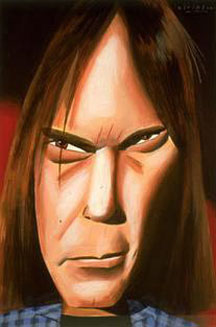
© MarkUlriksen/Rolling Stone magazine
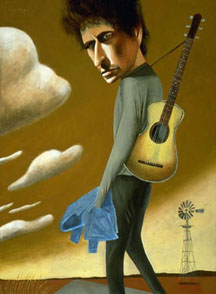
© MarkUlriksen/Civilization magazine
I think growing up my first love after my parents were The Beatles. I can't imagine life without music so I guess I do get inspired when I paint a musician. And when I work on those pieces I always play as much as of their music as I can. And It probably is easier to paint musicians whose music I like.
I have a thing for dogs as well and yes we have a one year old chocolate lab named Henry. I just completed my first kids book. It's called "Dog Show" and I included as many dogs as I knew in the paintings. I figure I'll probably be able to sell a dozen more books this way.
I'd say my work is first and foremost for magazines but I also have plans to do two more kids books soon. I do a little bit of book covers and advertising now and then. I have been doing an increasing number of portrait commissions of late (both family portraits and dog portraits) and soon I intend to paint images for a printer that they will then attempt to market.
I loved my work as associate art director at the magazine but once I was promoted to art director I lost interest. Art directing involves much more managerial and administrative tasks and I was only interested in being creative. I never took my ability to draw very seriously and never considered working as an illustrator full time but as I became discouraged with having the top position at the magazine (and after looking around at my peers and wondering where the old art directors were, it seems like a younger person's field) I thought perhaps I should consider illustration as a field. I was curious about how much I might improve as an artist if I did it everyday as opposed to the occasional evening or weekend spent painting.
Yes. Once I left design I wanted to immerse myself in art history as opposed to studying type faces and magazine layouts.
Absolutely. I love books and my favorite type of book is either an artists monograph or a museum's body of work. Plus if you spend too much time looking at your contemporaries you'll never really find your own path. I think a key to developing as an artist is to immerse yourself in the things YOU respond to, whether it's high brow or low, painted or not. I'm as influenced by movies, photography, architecture and cartoons as I am by the great masters of yore.
Thanks for mentioning him. I like his work as well but I don't have any books on him. In the realm of art my favorites are the early Flemish masters like Van Eyck, Van der Weyden, Christus, Memling. But my tastes change and my two most recent monographs are on Lucian Freud and Max Beckmann.
A limitation.
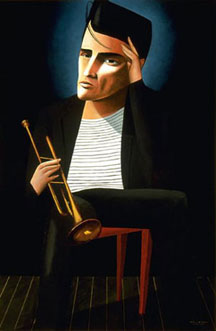
© MarkUlriksen/Thomas Reynolds Gallery
I know it when I see it. I like visually arresting stuff and I like problem solving in evidence. I'm not fond of decorative or derivitive work.
I love NYC in limited doses. I hope to live there someday but more likely when the kids are grown. With modern technology one can live anywhere. So living in NYC is not necessary but I'm a city guy. I like the hustle and bustle. San Francisco is a wonderful city, full of great light, views, cultural diversity and eccentric, tolerant folks. It reminds me a little of Italy, my favorite country by the way. The light in SF is similar to that in Rome.
I'm a little out of touch with the "scene". Underground presses are around but I don't know if they're thriving.
I've only done a little work in Europe. The nice thing is realizing people so far from home are aware of your work and it's a relief to think that there aren't people there doing something very similar to my own work. But it's almost not worth the monetary problems to court work in Europe. The pay is usually less, the time to get paid takes longer, the exchange rate fees come out of the budget etc. I honestly don't make much of an effort to look for work outside of the US.
Only a few. I'm friends with the Milanese illustrator Marco Ventura and I know his brother Andrea. I know Mattotti's work and I know a few Italians working in the US, Sergio Ruzzier, Riccardo Vecchio, Stefano Vitale. I've recently seen the work of Beppe Giacobbe and though I don't know where he's from I will say this: he's really good.
I've always been interested in showing in galleries because I love art on a larger scale and I'm so constricted by tight deadlines that working big is almost never an option. Plus I would like to get my work before as large an audience as possible and openings are a great way to find a more intimate reception to your work as well as soak up some feedback and (hopefully) good vibes.
I'm also aware of the fickle nature of pop culture and its hunger for the latest and greatest and I can't assume my work will always be in demand so I would like to cultivate a different breed of art connoisseurs.
In America Illustration is still given little respect but things are changing somewhat. Art galleries in NY and LA have had successful shows of contemporary illustrators. In NYC the Earl McGrath Gallery on W. 57th St. (good address!) has had big shows of Mark Ryden and Gary Baseman. In Los Angeles La Luz de Jesus shows Ryden, Baseman, The Clayton Brothers, Eric White, Owen Smith and others and the Hollywood scene shows up and pays top dollar for their works. I have seen the recent monographs on The Claytons , Eric White and Joe Sorren for sale at San Francisco's Museum of Modern Art. J. Otto Seibold has had installations at he Walker Art Center in Minneapolis. These are all big time scenes.
Personally I'm not ready for those galleries I've mentioned above but I have been approached by a very fine gallery in San Francisco (shows Gottfried Helnwein, R.Crumb, Glen Baxter among others) and all I need is the time to generate some work for them. But as we illustrators know a deadline is a great motivator so if I ever win the lottery I'll spend more time pursuing gallery shows but for now I must illustrate to make a living.
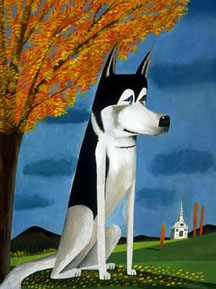
© MarkUlriksen/Yankee magazine
Hopefully evolving into doing fewer paintings and getting paid more for them. That would be sweet. I've been doing this for almost ten years now and the deadlines and small scale get old. I'm starting to do bigger pieces that take longer. I hope to always contribute to The New Yorker and I'd like to do a kids book annually. I intend to diversify as much as possible, having gallery shows, showing my work at street fairs, pursuing licensing opportunities (I've recently made magnets out of some of my paintings) and hopefully stay popular. Like I said, I'm not much of a screenwriter.